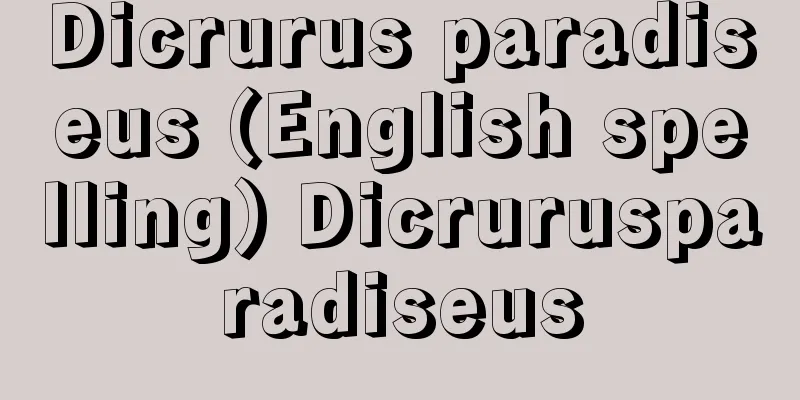Periodontitis

|
If gingivitis (an inflammatory disease of the gums) is left untreated, it can develop into periodontitis due to infection with periodontal pathogenic bacteria. There are various classifications of periodontitis, but when simply referring to periodontitis, it generally refers to marginal periodontitis. It was once called pyorrhea, but is now rarely used as an academic term. According to the Ministry of Health and Welfare (now the Ministry of Health, Labour and Welfare) Dental Disease Survey (1999), the prevalence of periodontitis is such that up until the early 20s, most cases are caused by gingival inflammation (approximately 55%), with periodontitis accounting for only 10%, but from then on, the prevalence increases with age, reaching approximately 43% for those aged 45-54 and approximately 50% for those aged 55-64. This suggests that gingivitis progresses to periodontitis from the late 20s onwards. [Ihachi Kato] Causes of periodontitis(1) Local causes The fundamental cause of periodontitis is a mixed infection with multiple periodontal pathogens, but other causative factors have also been identified. These are conditions on the part of the body that create an oral environment that is susceptible to bacterial infection or weaken resistance to bacterial infection. In addition to dental plaque and tartar, abnormally large forces applied to periodontal tissues, such as malocclusion, improper fillings or metal crowns, food impaction (food particles getting stuck between the teeth), and teeth grinding, are also cited as causes of periodontitis. Mouth breathing due to tonsillar disease, nasal disease, or maxillary protrusion can also be a cause. Of these, the most important causes of periodontitis are plaque and tartar that accumulate on the surface of the teeth. (2) Systemic causes: Systemic diseases such as diabetes, metabolic disorders including vitamin deficiency, drug poisoning, endocrine dysfunction, and malnutrition may also be the cause. [Ihachi Kato] Clinical manifestations(1) Periodontal pocket formation The disease spreads and expands to the deeper periodontal tissues, destroying the alveolar bone and periodontal ligament. As a result, the periodontal tissues peel off from the surface of the tooth root, forming a "gap" between the two. This gap is called a periodontal pocket, or simply a pocket. As the disease progresses, the depth of this periodontal pocket increases, so the extent of the progression of periodontitis can be determined by measuring its depth. (2) Tooth mobility When periodontal pockets form, the periodontal ligament that firmly attaches the teeth to the jawbone is destroyed, causing the teeth to become loose or to move or tilt abnormally. Eventually, the teeth will fall out. (3) Resorption of alveolar bone As periodontitis progresses, the alveolar bone that holds the teeth is gradually destroyed. The state of the alveolar bone can be detected by dental X-ray photography. (4) Discharge of pus from periodontal pockets When the affected area is pressed with a finger, exudate, exuded cellular components, blood, and other fluids known as pus will come out. (5) Pain Symptoms Periodontal disease is characterized by the lack of pain symptoms. When patients experience bite pain or spontaneous pain, the condition is often quite severe. (6) Risk factors for systemic diseases Many periodontal pathogens exist in the oral cavity of patients with periodontitis, which can cause infections in other organs. For example, it is known that there is an increased risk of developing hepatitis, endocarditis, myocardial infarction, cerebral infarction, and arteriosclerosis. It has also been reported that women with periodontitis are at higher risk of giving birth prematurely and giving birth to low birth weight babies. [Ihachi Kato] TreatmentInitial treatment(1) Oral Cleaning Method The most important and basic treatment for periodontitis is the removal of plaque and tartar. Because plaque is soft, patients can remove it relatively easily by themselves through daily plaque control. It is also said to be effective to thoroughly clean between the teeth using not only a toothbrush but also an interdental brush and dental floss at the same time. To remove tartar, scaling and root planning is performed to remove as much subgingival tartar as possible that adheres to the root surface of the teeth in the periodontal pocket. Tartar is formed when inorganic components such as calcium in saliva are deposited on old plaque, calcifying it, hardening it, and firmly adhering to the surface of the teeth. Tartar cannot be removed by a toothbrush or interdental brush, so dentists and dental hygienists use a scaler to remove it. (2) Occlusal adjustment method When abnormal force is continuously applied to a specific tooth in an abnormal direction or with abnormal strength, the alveolar bone that holds the tooth is gradually destroyed, the tooth becomes loose, and this results in the progression of periodontitis. In such cases, the shape of the tooth crown is corrected by a method called occlusal adjustment, so that the occlusal force applied to each tooth is evenly distributed. (3) Fixation method In cases where severe periodontitis has occurred and periodontal tissue has been significantly destroyed, chewing can cause abnormal forces to be applied to specific teeth or groups of teeth during or after treatment, which can lead to a worsening of clinical symptoms. In such cases, several teeth are fixed together with metal wires to give the teeth a sense of stability, suppressing tooth mobility and balancing the bite force. (4) Correcting bad habits. Mouth breathing reduces the resistance of the oral mucosa to various stimuli, promoting the progression of periodontitis. Teeth clenching and grinding while sleeping can also cause periodontitis, so correct these bad habits. [Ihachi Kato] Surgical treatmentSurgical treatment methods can be broadly divided into those that remove pathological periodontal tissue to remove periodontal pockets, and those that reattach the detached connection between the tooth root surface and periodontal tissue. The former is called gingivectomy, and the latter is called flap surgery. Other surgical treatment methods include gingival grafts, bone grafts, and gingival plastic surgery. In recent years, there has been active research in the medical field into regenerative medicine, which seeks to regenerate tissues or organs lost due to disease. In the dental field, guided tissue regeneration, which regenerates lost periodontal tissue, has been partially put to practical use and is attracting attention. [Ihachi Kato] Apical periodontitisApart from marginal periodontitis, there is apical periodontitis, which causes inflammatory lesions in the periodontal tissues around the root tip. It occurs secondary to pulp disease caused by caries or dental trauma. There are acute apical periodontitis and chronic apical periodontitis, the former of which is accompanied by severe pain. Differential diagnosis is easy with dental X-rays. Apical periodontitis is an indication for infected root canal treatment. [Ihachi Kato] "Periodontal Therapy, edited by Jun Ishikawa, 2nd Edition (1992, Ishiyaku Publishing)" [References] | | | | |Source: Shogakukan Encyclopedia Nipponica About Encyclopedia Nipponica Information | Legend |
|
歯肉炎(歯肉の炎症性の疾患)を治療しないまま放置すると、歯周病原細菌の感染によって歯周炎を継発する。歯周炎にはさまざまな分類があるが、単に歯周炎といった場合は一般に辺縁性歯周炎をさす。かつては歯槽膿漏(のうろう)ともよばれたが、現在は学術用語としてはほとんど使われていない。 歯周炎の罹患(りかん)率は厚生省(現厚生労働省)歯科疾患実態調査(1999)によると、20歳代前半までは大部分が歯肉の炎症で(約55%)、歯周炎は10%にすぎないが、それ以降は増齢的に増加し、45歳~54歳で約43%、55歳~64歳で約50%である。このことから歯肉炎は20歳代後半以降に歯周炎に移行することがうかがわれる。 [加藤伊八] 歯周炎の原因(1)局所的原因 歯周炎の根本的な原因は複数の歯周病原細菌の混合感染であるが、そのほかにも原因的因子が指摘されている。これらは細菌感染を受けやすい口腔(こうくう)内環境をつくりだしたり、細菌感染に対する抵抗力を弱めたりする生体側の状態である。歯垢(しこう)、歯石のほか、歯列不正、不適当な充填(じゅうてん)物または金属冠、食片圧入(歯と歯の間に食片が挟まること)、歯ぎしりなど異常に大きな力が歯周組織に加えられることも歯周炎の原因としてあげられている。また扁桃(へんとう)疾患、鼻疾患あるいは上顎(じょうがく)前突などに起因する口呼吸も原因となる。これらのうち、歯周炎の原因として重要なのは、歯の表面に堆積(たいせき)する歯垢と歯石である。 (2)全身的原因 糖尿病、ビタミン欠乏などの代謝異常、薬物による中毒、内分泌機能異常、栄養失調などの全身的疾患が原因となることもある。 [加藤伊八] 臨床症状(1)歯周ポケット形成 病変が深部の歯周組織に波及・拡大し、歯槽骨および歯根膜を破壊する。その結果歯周組織が歯根表面から剥離(はくり)し、両者の間に「すきま」が形成される。このすきまを歯周ポケット、または単にポケットという。この歯周ポケットは病気の進行に伴って深さを増していくため、その深さを測定することによって歯周炎の進行の程度を知ることができる。 (2)歯の動揺 歯周ポケットが形成されると、歯を顎骨にしっかりと結合させている歯根膜が壊されて、歯がぐらぐら揺れるようになったり、歯の病的な移動または傾斜がおこる。そして、最終的には歯は脱落する。 (3)歯槽骨の吸収 歯周炎の進行により、歯を保持している歯槽骨が徐々に破壊されていく。この歯槽骨の状態は、歯科用X線写真撮影によって知ることができる。 (4)歯周ポケットからの排膿(はいのう) 病変部を指で圧迫すると、滲出(しんしゅつ)液、滲出細胞成分、血液など、いわゆる膿(うみ)を排出する。 (5)痛み症状 歯周疾患は痛み症状が少ないのが特徴とされ、咬合(こうごう)痛、自発痛を自覚したときはかなり重症例が多い。 (6)全身疾患の危険因子 歯周炎患者の口腔内には多くの歯周病原細菌が存在するために、他臓器の感染症を引き起こす。たとえば、肝炎、心内膜炎、心筋梗塞(こうそく)、脳梗塞、動脈硬化を発症する危険が高まることがわかっている。また女性の歯周炎罹患者は早産による低出生体重児出産のリスクが大きいという報告もある。 [加藤伊八] 治療法初期治療(1)口腔(こうくう)清掃法 歯周炎の治療法のうちで、もっとも重要かつ基本的なのは、歯垢および歯石の除去である。歯垢は軟らかいため、いわゆる日常のプラーク・コントロールによって患者自身で比較的簡単に除去することができる。また、歯ブラシのみでなく、歯間ブラシ、デンタル・フロスなどを同時に用いて、歯と歯の間の清掃も十分に行うのが効果的であるといわれる。歯石を除くためには、歯周ポケット内の歯根面に付着する歯肉縁下歯石を可及的に除去する、スケーリング・ルートプレーニングを行う。歯石は、古くなった歯垢に唾液(だえき)中のカルシウムなどの無機成分が沈着して石灰化し、硬くなり、歯の表面に強固に付着したものである。歯石は歯ブラシ、歯間ブラシなどでは除去することが不可能なため、歯科医師や歯科衛生士がスケーラーscalerを用いて除去することになる。 (2)咬合調整法 特定の歯に異常な方向、あるいは異常な大きさの力が持続的に加えられると、歯を保持している歯槽骨が徐々に破壊され、歯は動揺するようになり、歯周炎の進行を助長する結果となる。こうした場合は、各歯牙(しが)に加わる咬合力がバランスよく分散するように、咬合調整法とよばれる歯冠形態の修正を行う。 (3)固定法 高度の歯周炎に罹患して、歯周組織の破壊が著しい場合には、治療中あるいは治療後に、そしゃくにより、特定の歯または歯群に異常な力が加わり、臨床症状が悪化しやすい。こうしたときは、歯に安静を与えるために数歯を金属線で連結固定し、歯の動揺を抑え、咬合力のバランスをとる。 (4)悪習慣の矯正 口呼吸があると口腔粘膜の種々の刺激に対して抵抗力が低下し、歯周炎の進行を助長する。また、歯の食いしばり、就寝時の歯ぎしりも歯周炎の原因となるので習慣矯正を行う。 [加藤伊八] 外科的治療法外科的治療法は、病的歯周組織の切除によって歯周ポケットを除去する方法と、歯根面と歯周組織の結合が剥離したときに、その部分を再付着させる方法に大別される。前者を歯肉切除法(歯肉切除術)、後者を歯肉剥離掻爬(そうは)術という。そのほかの外科的治療法としては歯肉移植、骨移植、歯肉整形術などがある。また近年医学領域において、病気によって失われた組織または臓器を再生させようとする、再生医療に関する研究が盛んに行われている。歯科領域では失われた歯周組織を再生する、組織再生誘導法が一部実用化され、注目されている。 [加藤伊八] 根尖性歯周炎辺縁性歯周炎とは別に根尖(こんせん)周囲の歯周組織に炎症性病変を形成する根尖性歯周炎がある。う蝕(しょく)または歯の外傷によって引き起こされる歯髄疾患に継発する。急性根尖性歯周炎と慢性根尖性歯周炎とがあり、前者では激しい疼痛(とうつう)を伴う。歯科用レントゲン写真撮影によって、鑑別診断は容易である。なお、根尖性歯周炎は感染根管治療の適応症である。 [加藤伊八] 『石川純編『歯周治療学』第2版(1992・医歯薬出版)』 [参照項目] | | | | |出典 小学館 日本大百科全書(ニッポニカ)日本大百科全書(ニッポニカ)について 情報 | 凡例 |
<<: Jishu death register - Jishu Kakocho
Recommend
Ferrous Acetate - Ferrous Acetate
Iron acetate with oxidation state II and iron acet...
Great ape - Ogataru Ijinen (English spelling)
They are the animals most closely related to human...
Bernard, H.
… [Judgment] The results of the verdict are shown...
Kaiso - Kaisou
… A lute-type stringed instrument consists of a m...
Champagne, P.de (English spelling) ChampagnePde
… French painter born in Brussels. Also known as ...
Lee, Bruce
Born: November 27, 1940, San Francisco, California...
Chiropractic - chiropractic
A treatment method that aims to alleviate and cur...
rhetoric
Originally, it was derived from the ancient Greek ...
Pineapple flower
Although it has the word "pineapple" in ...
Compressed Air Locomotive - Compressed Air Locomotive
…Compressed air engines, which are prime movers t...
Ungerer, T.
...J. Heartfield, who collaborated with him, used...
Marcic, R.
...H. Coing and H. Welzel are among those who spe...
Garrett (English name) João Baptista da Silva Leitão de Almeida Garrett
1799‐1854 Portuguese poet and playwright. He was a...
Prudhoe Bay
A small bay in the northern part of Alaska, USA. I...
Consolidated financial statements
Financial statements prepared by treating a corpo...









